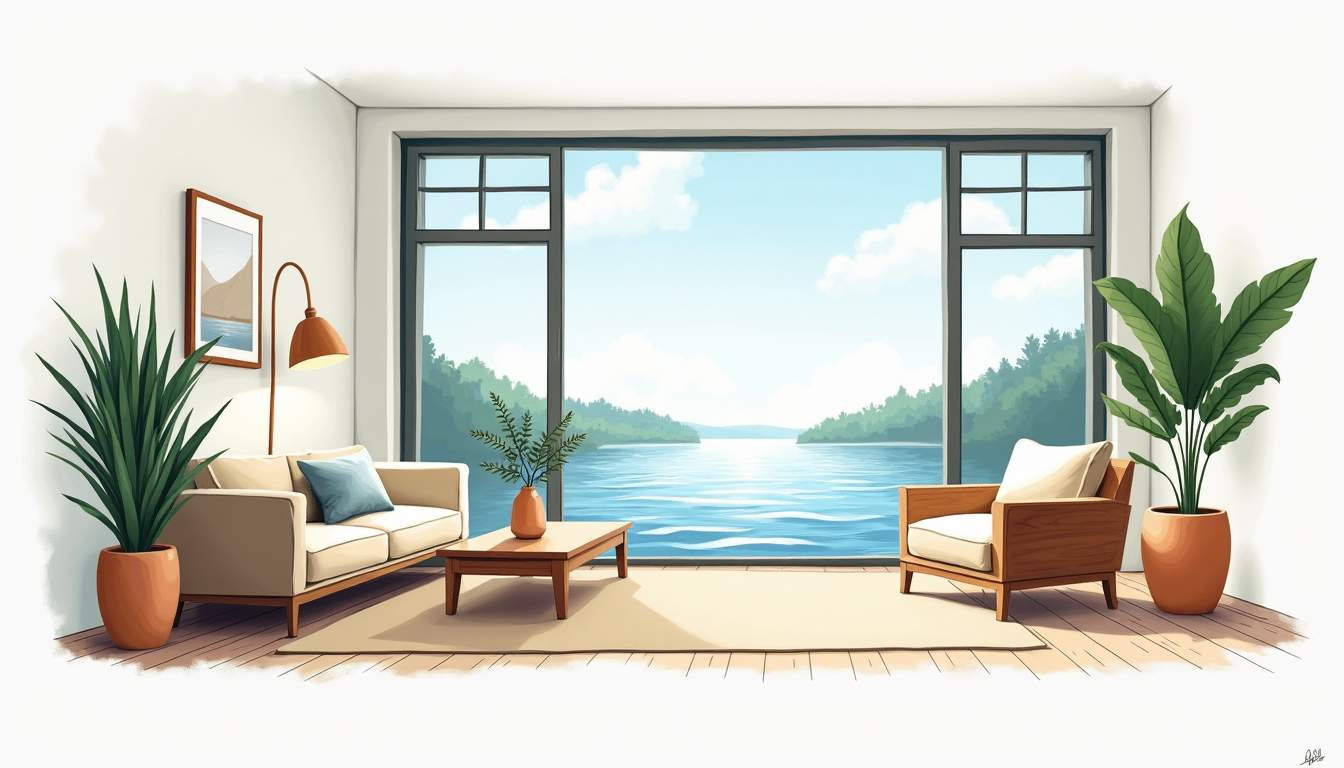
Living near water—whether an ocean, river, lake, or even a lively canal—does more than offer scenic views and calming breezes. There is growing evidence that proximity to water influences physical health, mental well-being, social connections, and daily habits. This article explores why waterfront living can be healthier, how different water environments contribute, and practical ways to bring some of that waterfront advantage into any lifestyle.
Research in environmental psychology and public health has repeatedly linked natural water environments to improved health outcomes. The presence of blue spaces—term often used to describe aquatic environments—has been associated with reduced stress, lower blood pressure, decreased anxiety, and better mood. Biophilia, the innate human tendency to seek connections with nature, helps explain why water holds such sway over emotional and physiological states.
In addition to psychological effects, being near water encourages physical activity. Walkable waterfronts, bike paths along rivers, and easy access to swimming or paddling naturally nudge people toward movement. Regular physical activity not only improves cardiovascular health but also supports better sleep, weight management, and metabolic function. A community designed around a waterfront often promotes incidental exercise through daily life—short strolls, dog walks, or commuting by bike—making fitness a built-in habit rather than an extra chore.
Moreover, water environments offer unique sensory experiences that contribute to mental well-being. The auditory rhythms of waves lapping against shores or the gentle splash of a stream can serve as calming stimuli, engaging multiple senses simultaneously and fostering mindfulness. This multisensory engagement helps individuals feel more grounded in the present moment, which is a key component of stress reduction techniques used in therapy and wellness practices.
Additionally, aquatic environments often foster social interaction and community cohesion. Waterfront parks and beaches provide natural gathering places where people can connect, relax, and participate in group activities like yoga, fishing, or community events. These social bonds formed around blue spaces further enhance emotional health and resilience by reducing feelings of isolation and encouraging a sense of belonging.
Viewing water activates the parasympathetic nervous system, the part of the nervous system responsible for rest and recovery. Studies using biomarkers like cortisol show lower stress levels after time spent near water. The rhythmic motion of waves or flowing currents can induce a meditative mental state, helping cognitive restoration after demanding work or long screen time. Even brief exposure, such as a 20-minute walk along a river, can lower perceived stress and refresh attention.
Beyond visual exposure, interactive engagement with water—such as swimming, kayaking, or even dipping feet into a stream—can deepen stress relief by combining physical movement with natural immersion. These activities stimulate endorphin release and promote neuroplasticity, enhancing mood and emotional regulation over time. Emerging research also suggests that blue space experiences can reduce symptoms in clinical populations suffering from depression and post-traumatic stress disorder when integrated into holistic treatment plans.
Waterfront microclimates often mean better air quality. Breezes from large bodies of water help disperse urban pollutants, reduce heat islands, and create more comfortable temperatures during hot months. Humidity can be higher close to water, which may benefit respiratory comfort for some people, though it’s not ideal for everyone. Still, the combination of cleaner air and cooler evenings provides a physiological advantage over tightly packed urban cores.
In addition, the presence of aquatic vegetation along shorelines contributes to improved environmental conditions. Plants like reeds and mangroves filter airborne particles and absorb carbon dioxide, further purifying urban air. These natural filtration processes work in tandem with water-driven airflow to enhance overall urban ecosystem health. Consequently, living or spending time near blue spaces can offer residents a respite from the adverse effects of urban pollution and climate extremes.
Design matters: cities and towns that invest in waterfront parks, promenades, and trails are creating a built environment that encourages movement. People are more likely to walk long distances for leisure if the scenery is stimulating and pathways are pleasant. Further, water-based recreation—swimming, kayaking, paddleboarding, sailing—offers low-impact exercises that are accessible across age groups and fitness levels.

Water activities tend to be easier on joints while still providing cardiovascular and muscular benefits. Swimming, for example, is recommended for those with arthritis or chronic pain because it supports the body while still delivering resistance. Paddling strengthens the upper body and core without the jarring impacts of running. These options make it realistic to maintain fitness across decades of life.
By contrast, living in car-dependent neighborhoods often translates into more sedentary time. Waterfront communities that emphasize walkability and access to public spaces create routines where incidental exercise becomes part of daily life. Short trips for coffee, groceries, or a quick shoreline stroll accumulate and produce measurable health benefits over time.
Mental well-being is perhaps the most visible benefit of waterfront living. Water landscapes support relaxation and cognitive recovery, reducing mental fatigue and boosting mood. The sound of waves or the sight of a slow-moving river can serve as a natural reset button, making it easier to manage anxiety and depressive symptoms for many people.
Blue spaces contribute to improved attention restoration and creative thinking. Time by the water can sharpen focus afterward, making it useful for those who need mental clarity after intensive work. Some studies suggest that even short periods of exposure to natural water scenes can lead to enhanced problem-solving and divergent thinking—useful traits for creative professions and problem-oriented tasks.
Waterfront areas often become gathering places: festivals at the marina, weekend market stalls by the quay, community fitness classes on the pier. Those shared spaces foster social ties, which are foundational to mental health. Strong social networks reduce loneliness, provide emotional support, and can even extend life expectancy. Waterfront neighborhoods frequently offer the infrastructure—parks, benches, boat launches—that makes neighborly interaction more likely.
Beyond individual health effects, waterfront living encourages lifestyle choices that align with sustainability and seasonal rhythms. Access to fresh water bodies supports local food traditions like freshwater fishing or shellfish harvesting in coastal regions. People tend to spend more time outdoors, which increases vitamin D exposure and can help regulate sleep cycles through natural light.
Outdoor lifestyles around water often translate to fresher food choices and more consistent sleep schedules. Evening walks or early morning swims expose residents to natural light, which entrains circadian rhythms and improves sleep quality. Meanwhile, local markets near waterfronts tend to offer seasonal produce and seafood, nudging diets toward whole foods that benefit cardiovascular and metabolic health.
Well-planned waterfronts prioritize pedestrian safety and public access. When investments go into good lighting, maintained pathways, and active public spaces, neighborhoods become both safer and more attractive for families and seniors. A sense of ownership and stewardship among residents can also lead to cleaner, better-maintained environments that reinforce healthy behaviors.
Waterfront living isn’t automatically perfect. There are considerations such as flood risk, seasonal storms, property costs, and sometimes higher humidity or insect activity. However, many of these issues can be managed through planning and sensible choices, turning potential negatives into manageable trade-offs.
Coastal and riverfront areas face increased flooding risk in many regions due to climate change. Choosing properties with appropriate elevation, flood mitigation infrastructure, and insurance is essential. Communities that invest in resilient design—like elevated public spaces, wetlands restoration, and seawalls—can protect residents and preserve the health benefits of waterfront access without exposing them to undue risk.
Waterfront properties can be expensive, and gentrification can push long-term residents out of neighborhoods that become desirable. To ensure equitable access to blue spaces, public planning should include affordable housing options, public parks with free entry, and community programs that keep waterfront amenities open to all. This democratic access preserves the public health advantages for a broader population.
Not everyone can move to a seaside town or riverside neighborhood, but many of the advantages of waterfront living are portable. Incorporating water into daily life, even in urban settings, provides measurable benefits.

Indoor fountains, courtyard ponds, or community splash pads can introduce calming water sounds into dense urban environments. Green roofs or pocket parks with running water improve microclimates and create small blue spaces that support relaxation. Even window views of a local pond or canal, or a skyline that includes a distant river, can contribute to restorative effects.
Recreating some routines—daily walks near any water source, regular swimming at a community pool, joining kayaking clubs—offers similar benefits. Prioritizing outdoor time, maintaining physical activity, and engaging in community events around water all help capture the mental and physical gains usually associated with waterfront lifestyles.
The appeal of waterfront living extends beyond photographers’ postcards. Blue spaces influence health through multiple pathways: reducing stress, encouraging physical activity, fostering social connections, and shaping healthier daily rhythms. While challenges like flood risk and affordability exist, thoughtful planning and individual choices can preserve the core benefits for a wide range of people.

Investing in accessible, resilient waterfronts and integrating water into urban design can produce healthier communities overall. Where moving to a shoreline isn’t possible, bringing elements of waterfront life into local neighborhoods and routines still supports improved well-being. A waterfront life isn’t simply a lifestyle upgrade; it’s an architecture of habits and environments that nurtures physical and mental health for the long term.
Embrace the benefits of waterfront living at Tennessee National, where luxury meets nature in a premier gated community. Enjoy stunning water views, access to a Greg Norman Signature Golf Course, a private marina, waterfront dining, and over 20 exclusive amenities designed to nurture your well-being. Whether you prefer a move-in ready home or a custom build, Tennessee National offers the perfect setting to cultivate healthier habits and vibrant social connections. Schedule your private tour today and start living the waterfront life you deserve.